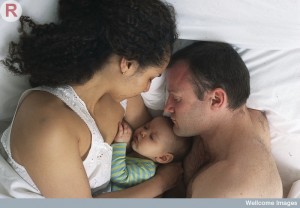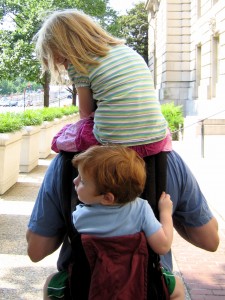 “A good night’s sleep” is a phrase I hear often in my house. Since our 18 month old enjoys a good night’s sleep most every night, it isn’t from her mouth that I hear the phrase (even if she could say it). Sometimes it is me making an excuse about why I felt unmotivated to get this or that done: “Oh, if I’d only had a good night’s sleep, then I would’ve . . .” But, more often I hear the phrase from my husband. We discuss family planning. This is never a good idea after we have not had a “good night’s sleep.” And, I’m learning, it isn’t a good idea to bring up family planning when my husband has had an overwhelming day at the office. On his more stressful days, he becomes passionate when the topic of sleep comes up: “I haven’t had a good night’s sleep in a year and half.” Annabelle giggles at him as though she knows exactly what he is saying. I try to hold back a smile (because our wakeful little girl is cute and has stolen my heart completely, sleep or no sleep). And then, together my husband and I share a moment adoring our daughter and I know we’re both thinking, “Isn’t she worth it?”
“A good night’s sleep” is a phrase I hear often in my house. Since our 18 month old enjoys a good night’s sleep most every night, it isn’t from her mouth that I hear the phrase (even if she could say it). Sometimes it is me making an excuse about why I felt unmotivated to get this or that done: “Oh, if I’d only had a good night’s sleep, then I would’ve . . .” But, more often I hear the phrase from my husband. We discuss family planning. This is never a good idea after we have not had a “good night’s sleep.” And, I’m learning, it isn’t a good idea to bring up family planning when my husband has had an overwhelming day at the office. On his more stressful days, he becomes passionate when the topic of sleep comes up: “I haven’t had a good night’s sleep in a year and half.” Annabelle giggles at him as though she knows exactly what he is saying. I try to hold back a smile (because our wakeful little girl is cute and has stolen my heart completely, sleep or no sleep). And then, together my husband and I share a moment adoring our daughter and I know we’re both thinking, “Isn’t she worth it?”
To be honest, we are sometimes sleep deprived. But for the most part, I know that I rack up a decent night’s sleep and am able to make up for lost sleep during the day, with my daughter napping beside me. I realize that my husband doesn’t have that option. He’s not your regular George Costanza, crawling under his desk to get some shut eye. But, my husband is one of those blessed people who sleeps through storms, probably air bombs, and definitely through the wakings of a teething toddler. What then are his less than “good night’s sleep”? I am guessing those are the nights when I, the ever waking mom, startle him from his sleep and beg for mercy from our daughter. Annabelle nurses through her teething pain, and after a few hours, non-stop breastfeeding is uncomfortable for me, not to mention difficult to sleep through.
Right now we are at a stand still. Annabelle falls asleep in her crib and remains there for several hours until her first waking. Once she is awake, I nurse her or my husband soothes her and she goes back to sleep in her crib. On other nights, she demands a place beside her mom and dad in our family bed. We all wake up together in our bed just about every morning.
My husband, meanwhile, outlines his plans for successfully making it through the entire night with our daughter sleeping in her crib. In the back of his mind, I know he wants to spend more time with me, more time playing pool, and more time just well, sleeping in.
The way I see our sleeping arrangement is that our daughter will gradually become more comfortable sleeping away from her parents, but that it is our job to encourage her trust in her parents as well as her own self-confidence by staying with her through the night, reassuring her that we are there for her no matter what.
And my husband agrees with my point of view, the latter part anyway. He is a most devoted and doting father. I observe the two of them walking together and playing. His voice changes when he speaks with her; he becomes a younger, more carefree version of himself. Even his body language loosens up. He no longer thinks about what is going on at his office, what deadlines are up, etc. He focuses entirely on his daughter.
So I asked him one night, “Do you think that your bond with Annabelle has anything to do with co-sleeping? I mean, think about it. You go to work all day and don’t see Annabelle. Yeah, you have some time with her at night, but just think about how many hours you two spend together sleeping, not to mention how you play together when you wake up in the morning.”
My husband fights a smile. “Maybe I’m just a good father?” he says. He hates to admit that he could ever be wrong about something, but maybe, just maybe, he senses an inkling of truth when it comes to how co-sleeping has benefited his relationship with our daughter.
For those of you who are co-sleeping or are considering co-sleeping, below are several articles addressing dads’ concerns about co-sleeping, the positive effects of co-sleeping with our children, and how to co-sleep safely:
- API’s Safe Sleep Guidelines
- API’s Nighttime Parenting Resources
- Dr. Sears’ Sleeping Safely with your baby
- Brand New Dad Co-sleeping thread
- Wears the Baby Ask Dad responds to question about co-sleeping


 This summer marks my 20th anniversary of parenting.
This summer marks my 20th anniversary of parenting. 